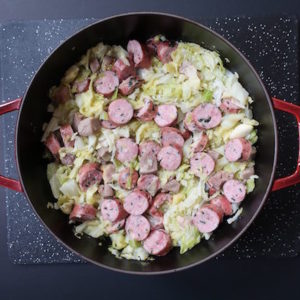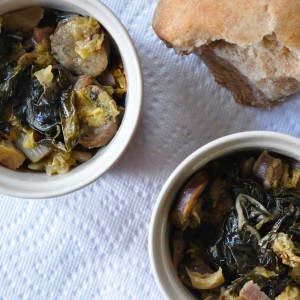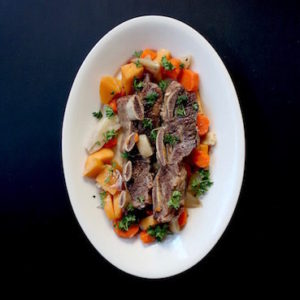Stuffed Cabbage
Stuffed cabbage exists in numerous cuisines, but the French have turned this abstemious dish into a delicacy. Recipes for chou farci range from the simple pork-wrapped parcels in Lulu’s Provencal Table to Goose Fat And Garlic’s outrageously rich recipe calling for ham, heavy cream, and cheese.

Then there are miques: entire cabbages carefully opened out, stuffed, painstakingly reassembled, and tied together. The entire bundle is poached in broth, then served as a separate course.

I made a mique once, following Paula Wolfert’s recipe in The Cooking Of Southwest France. It was indeed delicious, but extricating a boiling hot, volleyball-shaped cabbage from an equally boiling hot pot of soup is not my idea of fun.

A person could spend a fair amount of time cooking her way through the many variations of stuffed cabbage out there, French and otherwise (Eugenia Bone gives a fantastic Italian-American variation in The Kitchen Ecosystem) and it would be time well spent. For today, I took inspiration from Richard Olney. Writing in Simple French Food, Olney says:
to give a specific recipe is no doubt to falsify the spirit of the thing, for the only rule of its preparation is that it be based on bread panade thickened with egg….when it contains meat, it can be a chopped mixture of any odds and ends of leftover roasts, boiled meats, or poultry giblets.
With Mr. Olney’s words in mind, I combined smoked pork neck, belly, and some leftover cooked pork chop. Every recipe I read used approximately 1 pound/454 grams of stuffing; my recipe reflects this. Even so, I had a little stuffing left over–cabbage heads are not standard, after all–but this was no trouble. I tucked the extra filling into the baking dish, and served it.

A few words on cabbage stuffing technique:
Most stuffed cabbage recipes suggest either blanching the cabbage in salted water. While a few recipes suggest submersing the cabbage entire, more often the cabbage is disassambled. This is easier to do if you core the cabbage first. Should you tear or damage a leaf, fret not. Many cabbage leaves are large enough to stuff even if torn in two. Any small bits may be used to line the baking pan.

Many recipes also suggest paring any especially thick cabbage ribs. This seems a fussy step, but every time I’ve skipped it, I’ve regretted it. Pare the thicker ribs, and the finished dish is tender, easier to slice, and has that much more finesse–an adjective not often associated with cabbage. This is why the French are the French and the rest of us are proles.

As for blanching, this step is not a nicety, either: the hot water softens the leaves just enough to permit easy rolling. Once the leaves soften–a matter of moments–pluck them out with tongs and transfer them to a colander. As for the panful of water, save it for boiling potatoes, which you may serve alongside.

Not potatoes, but stuffing component.
Once you’ve prepared your stuffing and wrapped it up, you’ll need to chose a liquid to cook your cabbage in. Olney suggests good chicken broth. If you haven’t any decent broth, he suggests using water. Mme. Peyraud used the broth from her Pot-au-feu. I used the leftover cooking juices from pork chops, topping it up with a little Vermouth and water.

Above, the leftover cooking juices from pork chops.
Any leftovers will improve with a few days keeping.

In my usual fashion, I am managing to post this a few days before the American Thanksgiving holiday. I realize this. How many more ideas for stuffing do you need at this point?
I thought so.
Stuffed Cabbage
Prep time: 20-30 minutes hands on prep, then about an hour to bake.
Yield: Cabbages are not standard. Neither are appetites. For the post, I used one large cabbage, which yielded about 17 parcels, with some stuffing leftover. This was two meals for two moderate eaters.
This recipe may be easily scaled upward; keep in mind it’s quite filling.
Please read the notes for a discussion of alternative stuffings, including a non-pork alternative.
one large green cabbage, approx one pound/454 grams
For the Stuffing: Please see notes
a combination or one type of pork equalling about 1 pound/454 grams:
I used:
4 ounces/106 grams stale bread
2 ounces/55grams cooked pork chop
10 ounces/300grams smoked pork neck
5 ounces/145 grams pork belly
1 teaspoon dried thyme
1 teaspoon dried oregano
1 teaspoon dried fennel seed
salt and pepper
1 lobe shallot, peeled and minced
2 garlic cloves, peeled and minced
1 egg
splash brandy; optional
For the pan:
duck fat or butter
leftover cooking juices from another night; substitute broth, water, or wine; see notes
Instructions
You will need a large baking pan to make stuffed cabbage. A food processor is helpful but a large, sharp knife and patience will work.
Prepare the cabbage:
Put a large pot of lightly salted water on to boil.
Core the cabbage using a small, sharp knife. Set the core aside.
Remove each cabbage leaf with a gentle tug. If the leaves resist, try cutting a “V”-shaped notch in the bottom of each one to loosen it. Don’t worry if you tear the leaves; they’re still usable. Larger leaves may still be stuffed. Small bits may be incorporated into the stuffing or used to line the baking pan.
Use a small, sharp paring knife, carefully shave off the largest bits of cabbage rib on the biggest leaves.This is a pain, but the finished dish will be easier to eat. The parings can go into the bottom of the baking pan or be discarded; up to you.
Once the leaves are pared, lower leaves into the boiling water and push them down with a large wooden spoon or tongs. Keep leaves submerged until they’re just softened. This will take just a few minutes. Remove the leaves with tongs to a colander to drain and cool.
While the cabbage leaves cool, make the stuffing:
Soak the bread in just enough warm water to cover it. I heat the water in a microwave safe cup for 12 seconds, then drop the bread in it while I move on to the meats.
Pulse the meats in the food processor until pureed. Do this in batches if necessary. Dump them into your largest bowl. You can also chop them finely with a large, sharp knife. If you do this, it helps to chill the meats in the freezer first.
Add the seasonings, shallot, garlic, egg, and brandy, if using. Chop reserved cabbage core and add to the bowl. Mix everything well with clean hands or a large spoon.
Preheat the oven to 325F/160C.
Grease a large baking pan–I used a 11×17 inch (28cmx18cm) glass baking pan–with duck fat or butter. Add any broken bits of cabbage leaves or parings.
Blot the cabbage leaves dry with paper towels or a clean dish towel. Lay a cabbage leaf out flat in front of you, and place a tablespoon of filling in the center of the leaf. Roll the leaf up from the bottom, then tuck the open sides underneath. Lay the packet into the baking pan seam side down. So easy even klutzes like me can do it.
Keep going until you run out of cabbage leaves. Should you have any filling left over, tuck it into the pan, if there’s space, or you can freeze it and use it another day.
Add enough liquid–broth, water, wine–to come about halfway up the sides of the cabbage packages. Salt and pepper lightly.
Slide the baking pan into the oven and bake for about one hour, or slightly over, checking at halfway mark for liquid and to ensure cabbage is not browning too much; if it is, cover pan with foil.
The stuffed cabbage is ready when a test probe slides in easily, comes out clean, and cabbage is browned, smells done, and there is no sign of raw, pink, or underdone meats. If you are unsure, cut into a package and check.
Serve stuffed cabbage with boiled or mashed potatoes, carrots, or any member of the root vegetable family.
Stuffed cabbage keeps well, refrigerated, up to five days. It freezes beautifully. You can prepare stuffed cabbage unbaked, freeze it, and cook it from frozen, but be sure your cooking vessel can tolerate going from freezer to oven, and give it additional cooking time.
Notes:
Stuffed cabbage may also be cooked stovetop; bring the liquid to a gentle simmer, cover the pan, and turn heat to medium low. If your burners run very hot, use a flame tamer. Total cooking time will be about ninety minutes, or, if you wish, turn the heat to a bare simmer and it can be left alone for about two hours.
As noted in the post, stuffed cabbage fillings are so variable that it’s difficult to shoehorn them into a recipe’s confines. Do aim for about one pound of filling (454g) for a large cabbage. Any leftover may be cooked in the pan, if there’s space. You could also form any leftover filling into small patties or loaves and bake them in a 350F/180C oven; cooking time will be 45 minutes to an hour.
I have tried this recipe with ground chicken, and while it’s workable, care must be taken to ensure the mix is flavorful and moist. Adequate fat is crucial–chicken, or ideally, duck fat–will take up any slack. Duck fat is increasingly available in markets, and while it can be expensive, a little goes a long way. And it keeps beautifully in the freezer.
The recently deceased Lulu Peyraud, of Domaine Tempier vinyards, was famous for her cooking. In Lulu’s Provencal Table (authored by Richard Olney) she gives a recipe for stuffed cabbage using 1/2 pound (113g) rice and 1/2 pound (113g) sausage meat.
Sausage mixtures make excellent cabbage stuffings. If possible, buy bulk, or loose sausagemeat, as some commercial sausage casings cling stubbornly to their contents.
Smoked pork products–or smoked chicken, if you can get it–are delicious here, but use sparingly if heavily smoked or salted, lest they take over. Not sure? Form your filling into a small patty, fry, and taste for seasoning.
In terms of cooking liquids, Olney says use excellent broth, or, barring that, water. Mme. Peyraud used the broth from her Pot-au-feu. Chicken, vegetable, or light beef broth work well here, as does light white wine or Vermouth.
I use a toothbrush to clean my food processor blade.





